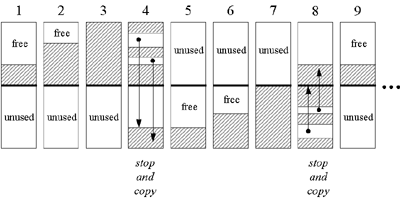|
|
|
Sponsored Link •
|
|
Advertisement
|
Copying garbage collectors move all live objects to a new area. As the objects are moved to the new area, they are placed side by side, thus eliminating any free space that may have separated them in the old area. The old area is then known to be all free space. The advantage of this approach is that objects can be copied as they are discovered by the traversal from the root nodes. There are no separate mark and sweep phases. Objects are copied to the new area on the fly, and forwarding pointers are left in their old locations. The forwarding pointers allow the garbage collector to detect references to objects that have already been moved. The garbage collector can then assign the value of the forwarding pointer to the references so they point to the object's new location.
A common copying collector algorithm is called "stop and copy." In this scheme, the heap is divided into two regions. Only one of the two regions is used at any time. Objects are allocated from one of the regions until all the space in that region has been exhausted. At that point program execution is stopped and the heap is traversed. Live objects are copied to the other region as they are encountered by the traversal. When the stop and copy procedure is finished, program execution resumes. Memory will be allocated from the new heap region until it too runs out of space. At that point the program will once again be stopped. The heap will be traversed and live objects will be copied back to the original region. The cost associated with this approach is that twice as much memory is needed for a given amount of heap space because only half of the available memory is used at any time.
You can see a graphical depiction of a garbage-collected heap that uses a stop and copy algorithm in Figure 9-1. This figure shows nine snapshots of the heap over time. In the first snapshot, the lower half of the heap is unused space. The upper half of the heap is partially filled by objects. That portion of the heap that contains objects is painted with diagonal gray lines. The second snapshot shows that the top half of the heap is gradually being filled up with objects, until it becomes full as shown in the third snapshot.
At that point, the garbage collector stops the program and traces out the graph of live objects starting with the root nodes. It copies each live object it encounters down to the bottom half of the heap, placing each object next to the previously copied object. This process is shown in snapshot four.
Snapshot five shows the heap after the garbage collection has finished. Now the top half of the heap is unused, and the bottom half is partially filled with live objects. The sixth snapshot shows the bottom half is now becoming gradually filled with objects, until it too becomes full in snapshot seven.
Once again, the garbage collector stops the program and traces out the graph of live objects. This time, it copies each live object it encounters up to the top half of the heap, as shown in snapshot eight. Snapshot nine shows the result of the garbage collection: the bottom half is once again unused space and the top half is partially filled with objects. This process repeats again and again as the program executes.

|
Sponsored Links
|